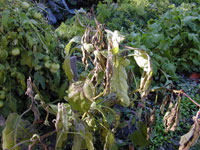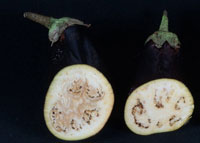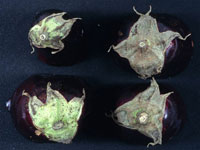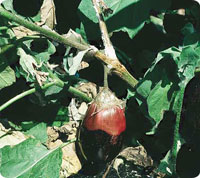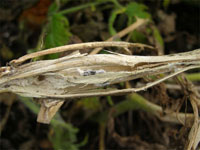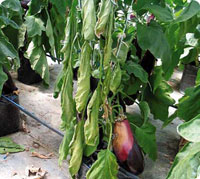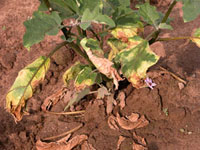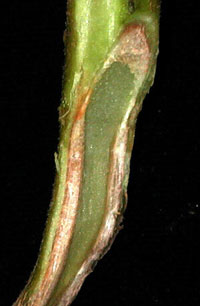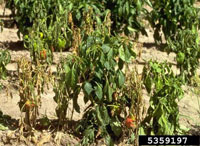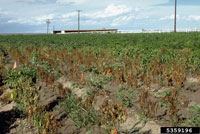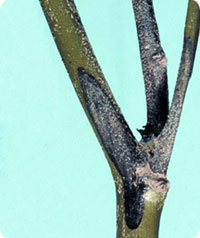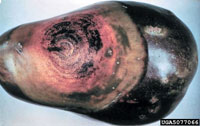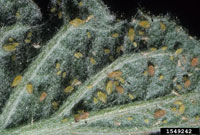Extension > Garden > Diagnose a problem > What's wrong with my plant? > Vegetable > Eggplant > Leaves wilt
Eggplant > Leaves > Leaves wilt
1 of 6
Frost Damage/Chilling Injury
- Leaves look water-soaked and soft, then turn black
- Surface of fruit appears bronzed
- Seeds and inside of fruit are brown
- Fruit becomes soft water-soaked and rots
- Leaves show injury immediately, fruit may not show symptoms for 5 to 7 days
- Eggplant is more sensitive to cold than tomatoes and peppers
2 of 6
White Mold
Sclerotinia sclerotiorum
- Dark, firm water soaked lesion on stem
- Girdled stems die and turn bone white
- Inside dead stems are black mouse poop like sclerotia
- Fruit are soft and rotted
- Cottony white mycelia inside and outside infected stems when humidity is high
- Favored by cool humid conditions
- More information on White Mold
3 of 6
Verticillium Wilt
Verticillium spp.
- Leaf edges and tips turn yellow
- Eventually entire leaves yellow and wilt
- Symptoms often affect one side only
- Lower leaves wilt first, eventually whole plant wilts
- In a lengthwise cut of the stem near the soil line, veins are tan, center is green
- More information on growing healthy vegetables
4 of 6
Phytophthora Blight
Phytophthora capsici and Phytophthora parasitica
- Entire plant wilts and turns brown
- Soft, dark, water soaked spots form on fruit
- Water soaked to tan bleached spots may form on leaves
- Fruit wither but remain attached and become coated in white fungal growth
- Dark sunken spots form on stems, all leaves beyond this spot wilt
- Disease spreads very rapidly in cool wet weather
- More information on growing healthy vegetables
5 of 6
Phomopsis Blight
Phomopsis vexans
- Stems develop dark sunken lesions just above the soil line
- Seedlings may collapse and die
- Leaves develop circular, gray to brown lesions with a light center
- Severely infected leaves become torn, yellow, wilt and drop
- Fruit develops pale, sunken, oval spots
- Concentric rings of tiny black dots can be seen in fruit infection
- More information on Phomopsis Blight
6 of 6
Potato Aphid and Green Peach Aphid
Macrosiphum euphorbiae and Myzus persicae
- Small insects, pear-shaped, usually greenish; clustered on underside of leaves, about 1/10th inch long
- Feeding by small or moderate numbers of aphids usually does not cause visible symptoms; feeding by larger numbers of aphids can cause curling, stunting, and wilting of leaves
- Active during spring and summer
- More information on Potato Aphid and Green Peach Aphid



